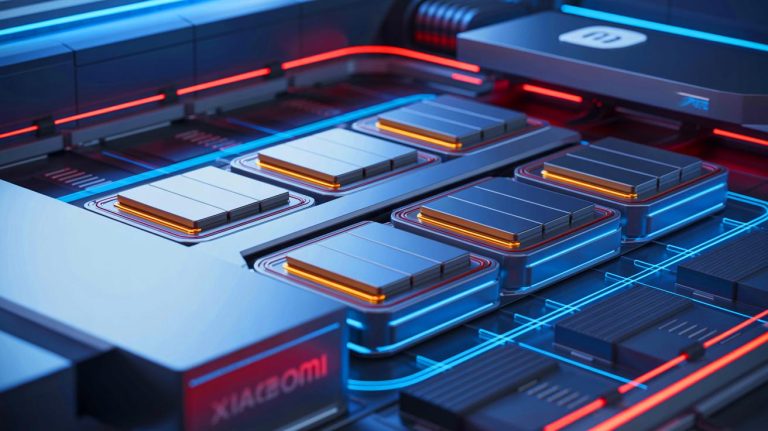| IN A NUTSHELL |
|
Xiaomi’s recent patent filing for a solid-state EV battery with a layered electrode design has set the stage for a potential revolution in energy storage technology. This development underscores the growing momentum among leading tech companies to push the boundaries of what electric vehicle batteries can achieve. With a focus on improving ionic conductivity and energy density, Xiaomi’s innovation could be a game-changer in the battery industry. As the world looks towards more efficient and sustainable energy solutions, the implications of this breakthrough are profound, promising a future where electric vehicles are not only more efficient but also more accessible.
Xiaomi’s Innovative Layered Electrode Design
Chinese tech giant Xiaomi has unveiled a groundbreaking innovation in the world of solid-state batteries through its newly filed patent focusing on a layered electrode design. This approach addresses the critical issues of ionic conductivity and energy density, which have long been challenging in the development of next-generation battery technologies. The design incorporates a multi-layered electrode structure, with each layer comprising active materials, conductive agents, binders, and a solid electrolyte made from polymers and metal salts. This electrolyte is designed to penetrate vertically through the electrode, which significantly reduces the distance ions need to travel, thereby enhancing the overall performance of the battery.
Moreover, Xiaomi’s design is compatible with existing lithium battery manufacturing lines, which means that it could streamline future mass production efforts. This compatibility is crucial as it allows for a smoother transition to solid-state technology, potentially accelerating the adoption of these advanced batteries in the market. The implications of this innovation are vast, promising not only improved battery performance but also a more efficient manufacturing process.
Remarkable Performance Specifications
Xiaomi claims that its prototype battery features a cell-to-body (CTB) design with a volume efficiency of 77.8%. This innovative structure allows the battery pack to measure only about 4.7 inches in height, including the vehicle floor, which enhances space utilization and improves weight distribution in electric vehicles. The battery delivers an impressive CLTC-rated range of over 745 miles and supports fast charging capabilities that can add 500 miles of range in just 10 minutes. Such specifications not only highlight the potential of solid-state batteries to revolutionize electric vehicles but also underscore the practical advantages these batteries can offer in terms of efficiency and performance.
The potential for rapid charging and extended range addresses two of the most significant concerns for electric vehicle users: range anxiety and charging time. By potentially alleviating these issues, Xiaomi’s innovation could play a pivotal role in increasing the adoption of electric vehicles globally, providing a more viable alternative to traditional combustion engines.
Industry-Wide Implications and Competition
The involvement of Xiaomi in the solid-state battery race reflects a broader industry trend, with major global players like CATL, BYD, Toyota, SAIC, and BMW heavily investing in similar technologies. For instance, BMW is already road testing a prototype i7 model equipped with solid-state battery technology, while CATL and SAIC are targeting small-scale production by 2027. Toyota plans to launch its first solid-state battery vehicles between 2027 and 2028, further emphasizing the growing momentum for next-generation energy storage solutions across the automotive industry.
This industry-wide focus on solid-state batteries is driven by the need for safer, more efficient, and longer-lasting energy storage solutions. Replacing the liquid electrolyte in traditional lithium-ion cells with solid materials, solid-state batteries promise significant improvements in energy density, safety, and thermal stability. As such, the competition among these industry giants is not just about technological advancement but also about securing a leading position in the rapidly evolving electric vehicle market.
Challenges and Future Prospects
Despite the potential benefits, the development and commercialization of solid-state batteries are not without challenges. Major obstacles include low ionic conductivity, issues with interfacial contact, and the formation of lithium dendrites. Researchers are actively exploring three main types of solid electrolytes—sulfide, oxide, and polymer—each offering varying balances of conductivity, stability, and ease of manufacturing.
Furthermore, Xiaomi’s latest patent could enable the company to integrate its own solid-state batteries into upcoming electric vehicles, potentially reducing reliance on third-party suppliers like CATL and BYD. This strategic move not only highlights Xiaomi’s commitment to innovation but also positions the company as a formidable player in the future of electric vehicle technology.
As the race to develop and mass-produce solid-state batteries accelerates, the automotive and tech industries stand on the cusp of transformative change. With companies like Xiaomi leading the charge, the potential for safer, more efficient, and longer-lasting energy storage solutions is within reach. How will these advancements reshape the landscape of the electric vehicle market, and what new opportunities will they create for the future of sustainable transportation?
Did you like it? 4.4/5 (29)







This is amazing news! 🚗🔋 How soon can we expect to see these batteries in mass production?
Are there any environmental concerns related to the production of these solid-state batteries?
Wow, 500 miles in 10 minutes? That sounds like science fiction! 🤯